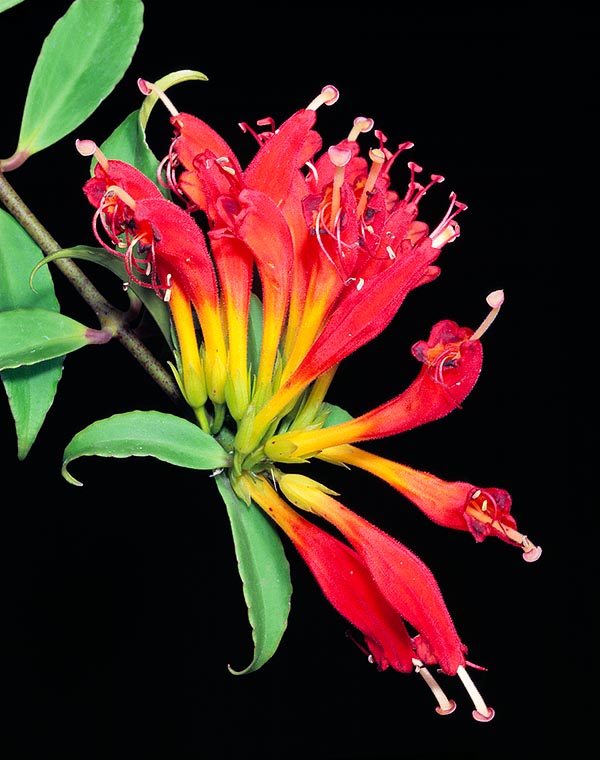Family : Gesneriaceae

Text © Pietro Puccio

English translation by Mario Beltramini

Native to South-East Asia Aeschynanthus speciosus is a very floriferous species © Giuseppe Mazza
This plant is native to Indonesia and Malaysia, where it grows as epiphytic on the trees in the pluvial forests at an altitude going from 150 to 1.900 m.
The name of the genus comes from the combination of the Greek words “aischyne” = shame, shyness and “anthos” = flower, with reference to the red colour of the flowers of many species belonging to the genus; the name of the species is the Latin adjective “speciosus” = beautiful.
Common names: basket plant, lipstick plant (English); Schamblume (German) .
The Aeschynanthus speciosus Hook. (1847) is an epiphytic evergreen plant with semi-erect or hanging branches, up to 60 cm long, and elliptic, or ovate, leaves rather fleshy, usually opposite, at times verticillate (three or more per each node), of glossy dark green colour on the upper pagen, paler below, 5-15 cm long and 2-5 cm broad, with sharp or caudate apex.
The inflorescences are terminal, compact, carrying 4-16 tubular, curved, flowers, 6-11 cm long and 2,5 cm broad, with five rounded lobes of an orange red colour.
The fruits are 20-40 cm long and thin, about 3 mm, capsules, containing hairy seeds, about 1 mm long.
It reproduces by seed and by cutting in spring utilizing 10-15 cm long portions of branch, on a sandy substratum, or rich of agri-perlite, at a temperature of 20-24 °C, in a location with high atmospheric humidity, or, failing this, encasing the pot in plastic bag for maintaining the humidity; it may also reproduce by leaf cutting, but with longer times.
Much floriferous species to be cultivated as epiphytic on the trees or in hanging pots in very luminous position, but not in direct sun, in the tropical and humid subtropical climate; it requires a much porous substratum which may be formed by coarse peat with 30% of siliceous sand or agri-perlite.
Watering must be regular during the vegetative period, but without stagnations which may be harmful; the nebulisations with non calcareous water are useful, in particular during the warmest periods if the atmosphere is too dry; during the resting time, the watering must be reduced in such a way to leave the superior layers of mould to dry up, before giving water again. In the places where the climate does not allow the permanent cultivation in open air, it is to be sheltered in a very luminous location at a temperature of not less than 16 °C, even if it may bear some degree less for a short time; if the local humidity is low, the pot may be placed on a wide saucer full of expanded clay or rubble with a layer of water, not in direct contact with the bottom of the pot, in way to increase the humidity.
The displacements and the sudden variations of temperature during the blooming are to be avoided, as this may cause the premature fall of the flowers. The pruning is to be done by early spring or immediately after the flowering; the change of pot is to be effected in spring when the substratum becomes compact, roughly each 2-3 years.
Synonyms: Aeschynanthus aucklandiae H.Low (1849); Aeschynanthus splendens Lindl. & Paxton (1852).
→ To appreciate the biodiversity within the GESNERIACEAE family please click here.
